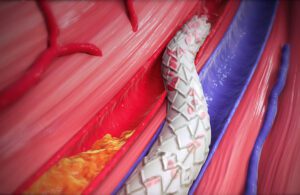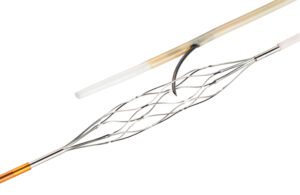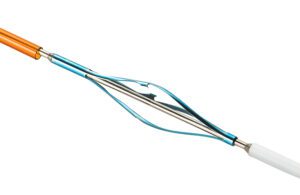
LimFlow’s crossing stent diverts blood from a diseased tibial artery to a tibial vein to deliver oxygen to a patient’s ischemic foot. [Illustration courtesy of LimFlow]
For CLTI patients who have lost blood flow below their knee and have no other suitable endovascular or surgical treatment options available, the LimFlow System for Transcatheter Arterialization of Deep Veins (TADV) is now the last resort to avoid amputation.
LimFlow’s TADV system won breakthrough device designation in October 2017 and secured FDA premarket approval (PMA) in September 2023.
In November, Inari Medical announced a definitive agreement to buy LimFlow for up to $415 million and closed the deal a couple of weeks later.
“A lot of technologies come out of people fiddling with technologies that already exist, and then developing unique proprietary solutions after that,” LimFlow CEO Dan Rose said in an interview with Medical Design & Outsourcing before the deal was announced. “That was kind of our journey. … We hope to break a logjam, which is the limits of [applying traditional] coronary technology below the knee by creating a new circuit that allows us to deliver the oxygenated blood these patients need.”
LimFlow’s minimally invasive procedure diverts blood around diseased arteries and into veins to restore blood flow into a patient’s ischemic foot.
TADV relieves ischemia by using veins to oxygenate tissue (essentially turning them into arteries), a relatively simple concept that goes back more than a century. But the risks of creating such a large surgical wound — including infection that could require amputation — have historically outweighed the benefits.
However, modern coronary and peripheral interventional medicine and the ever-growing use of catheters, wires, stents and balloons now allows surgeons to make small, precise punctures in the vasculature.
“How we actually did the first-in-man was saying, ‘How can we try to use just interventional techniques to accomplish the goal with a surgical procedure [using] off-the-shelf devices? And that was the beginning of LimFlow — using common tools to prove the principle,” Rose said.
How LimFlow’s devices restore blood flow

LimFlow’s ARC arterial catheter (pictured with needle extended) and the mesh V-Ceiver venous catheter [Image courtesy of LimFlow]
One example is LimFLow’s proprietary technology for artery-to-vein crossing. They designed their nitinol V-Ceiver venous catheter with radiopaque mesh to expand inside the tibial vein, providing a clear target with fluoroscopy so the nitinol needle on LimFlow’s ARC arterial catheter inside the tibial artery can puncture the vein and deliver a micro guidewire. The V-Ceiver’s snaring mesh captures the guidewire, which then runs out of the venous access site on the patient’s foot.
Then, an angioplasty balloon opens up the artery-vein connection. Next, the LimFlow Valvulotome cuts through vein valves at the bottom of the foot to allow the blood to flow in the opposite direction.
Self-expanding stent grafts covered with electrospun polytetrafluoroethylene (PTFE) run up the leg to keep the vein open. The last piece of the puzzle is LimFlow’s self-expanding nitinol crossing stent, which is also covered with electrospun PTFE and routes oxygenated blood from the artery into the vein, restoring a rush of blood flow to the foot. (You can watch the entire procedure in the video at the bottom of this post.)

The LimFlow Valvulotome [Image courtesy of LimFlow]
Creating these tools wasn’t enough; they needed to be refined for speed, simplicity and dependability.
“All interventionalists have a spectrum of skills, and we have to aim for a procedure that is reproducible in the hands of the average physician. Because if you don’t, you’re building a niche technology,” Rose said.
What’s next for LimFlow
CLTI is often seen in patients with diabetes, coronary artery disease, obesity or high blood pressure. It’s estimated to affect as many as 4 million people in the U.S., causing 150,000 amputations per year in late-stage patients whose limbs can’t be saved with angioplasty or open bypass surgery.
Amputations above the ankle for vascular disease are associated with a 50% mortality rate within a year. For those who survive, losing a limb means they may never walk again.

LimFlow CEO Dan Rose [Photo courtesy of LimFlow]
It’s not every patient, he said, but a significant majority save their limbs.
Now that LimFlow is able to treat the most serious cases, they’re still studying how they can expand their system to patients in less advanced stages. That includes revising their products and developing new ones. They’re already working on a new PMA submission, Rose said, though he declined to offer details.
“We’ve opened a new circuit, a new pathway,” Rose said. “We have to learn how to use that, we have to learn which patients it’s ideal for. That will take place over time. … I can’t speak openly about it, but we are and will be developing new technology solutions that make the procedure easier and faster and better as we go.”
“We’re passing through the first door,” he continued, “but there are many, many further doors to open, and the only way we do that is by continuing the journey.”
Read more: “Maybe we’re overthinking it” — LimFlow CEO says a tough call was the right call
This post was originally published on Sept. 21, 2023, and updated in November 2023 with news of Inari Medical pending acquisition and then completed purchase of LimFlow.




